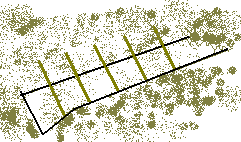Propagation by Cuttings
Many plants can be propagated from cuttings but the type of cutting to prepare depends upon the plant and the time of the year.
A wide range of plants can be increased from softwood cuttings. These are prepared from soft young shoots early in the year (April - June) then, as the stems of the plants start to harden, semi-ripe cuttings can be taken. These are usually between July - October. Once the stem has become woody, hardwood cuttings are taken. This is usually early to mid winter (November/December)
Methods -
Softwood Cuttings
Most deciduous shrubs ( Buddleia, hypericum, weigla) can be propagated with softwood cuttings.
Softwood cuttings lose water very quickly and will wilt. For this reason, prepare your pots or trays of compost before taking any cuttings. For just a few cuttings, a pot can be used but for a larger quantity a tray is recommended. Use a propriety cutting compost or mix sharp sand and general purpose compost as a 50 - 50 mix. Vermiculite can be used in place of the sand if required. Fill the pot to within ½ inch (1cm) of the top and firm gently and level off. Make holes around the sides with a dibber (a pencil makes a good dibber for cuttings). Do not make the holes too deep, the bottom of the cutting will need to be in firm contact with the compost. You are now ready to take the cuttings.
Cut the tip of a non-flowering shoot about 3 inches (2.5cm) from the end, just under a leaf joint (or node). It is good practice to place them in a polythene bag to avoid excess water loss while other cuttings are taken.
Trim off the lower leaves close to the stem. If required the whole cutting can be dipped in a fungicide solution but as long as your compost is fresh and your knife is clean, this should not be necessary. Dip the bases of the cuttings into a hormone rooting compound (either liquid or powder), tap off any excess and place each cutting into the holes you made in the compost. Firm the compost around the cutting to ensure that there are no air pockets and water well with a watering can with a fine rose so as not to disturb or wash away the compost.
Place the pot into a polythene bag and secure the top with a wire tie to prevent loss of moisture. Put in a warm, light place, away from direct sunlight. A kitchen window sill is usually a good place. A much better way is to place into an electric heated propagator that can supply bottom heat and a constant temperature (70 F). These can be purchased fairly cheaply.
Some softwoods plants such as fuchsia, coleus and tradescantia can be rooted simply by standing them in a jar of water on a warm window sill.
Semi - Ripe Cuttings
These are treated exactly the same as softwood cuttings but are taken when the wood of the stem is hardening but the stem tip is still soft. They do not need as much heat as softwood cuttings though and are usually placed into a coldframe.
Hardwood Cuttings
These cuttings need no heat at all to root and are usually done in a prepared, well-drained, sheltered area of the garden. Common examples of shrubs and soft fruit bushes raised from hardwood cuttings are Privet, Willow, Dogwood, Blackcurrant, Redcurrant and Gooseberry.
Choose the present years shoots that are completely ripe and woody and cut them about 12 inches (30cm) long with sharp secateurs. Cut just above a bud at the top and just below a bud at the base. If taking Blackcurrant or gooseberry cuttings remove all but the top 4 buds, any other cuttings, the buds can be left on.
Although it is not really necessary, the bases can be dipped in hormone compound if you prefer.
Prepare the planting site in a sheltered spot in the garden. The soil should be well-drained so, if your soil is on the heavy side, work in some coarse grit or sand to improve the drainage.
Using a garden spade make a 'V' shaped slot about 8 inches (20cm) deep, the length depends on how many cuttings you have. The easiest way of doing this is to push the spade into the ground to most of the spades depth and the rock the handle back and forth to create the 'V' shape.
 Place the cuttings in the slot to approximately two thirds of their length and firm the soil back around them to ensure that no air pockets are left (Roots will not form into air pockets). If you wish sharp sand can be put in the base of the slot before filling in, this will help with drainage.
Place the cuttings in the slot to approximately two thirds of their length and firm the soil back around them to ensure that no air pockets are left (Roots will not form into air pockets). If you wish sharp sand can be put in the base of the slot before filling in, this will help with drainage.
By the following autumn the cuttings will be rooted and ready for lifting and transplanting to their final positions.
© copyright 1999, P. A. Owen

